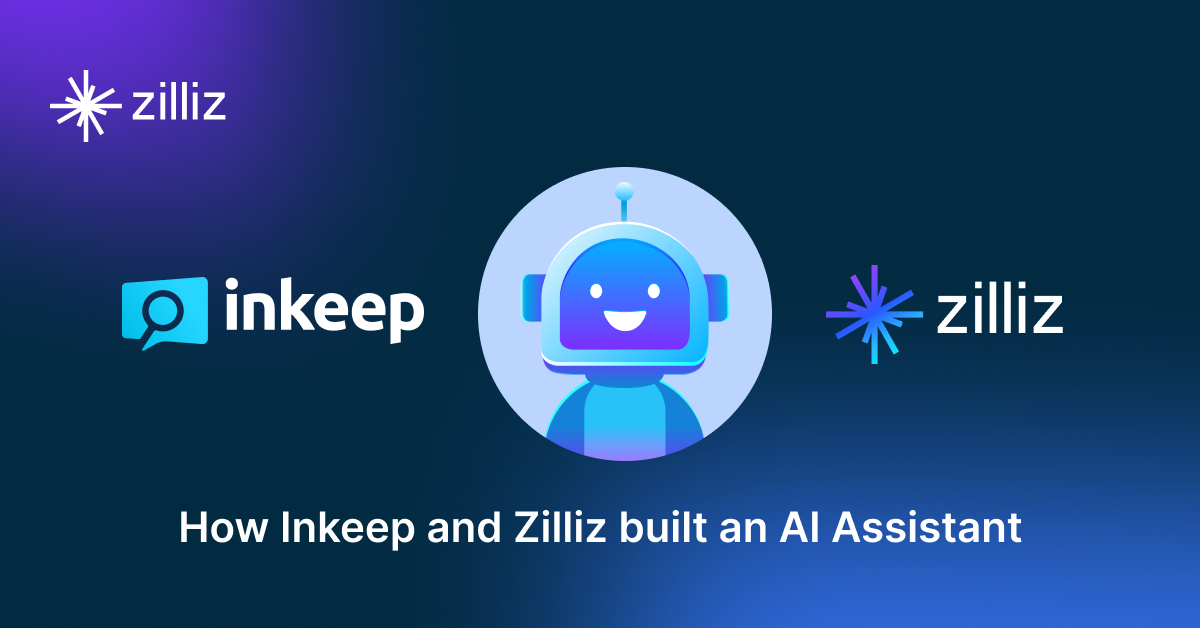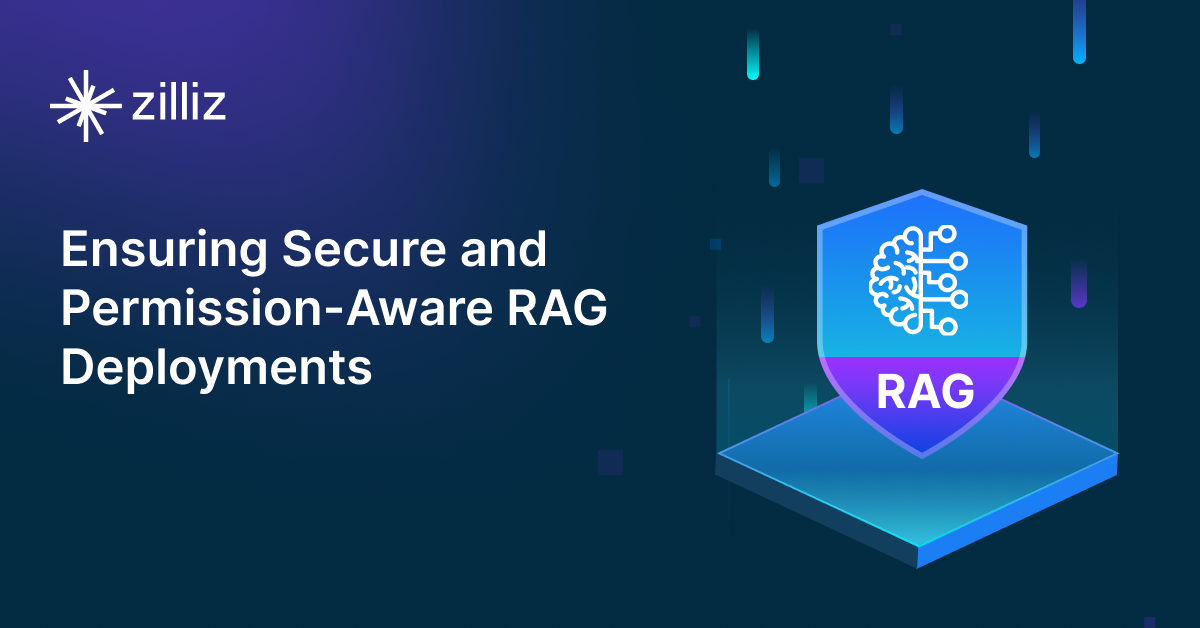Build RAG Chatbot with LangChain, Milvus, Cohere Command R, and Ollama granite-embedding
Introduction to RAG
Retrieval-Augmented Generation (RAG) is a game-changer for GenAI applications, especially in conversational AI. It combines the power of pre-trained large language models (LLMs) like OpenAI’s GPT with external knowledge sources stored in vector databases such as Milvus and Zilliz Cloud, allowing for more accurate, contextually relevant, and up-to-date response generation. A RAG pipeline usually consists of four basic components: a vector database, an embedding model, an LLM, and a framework.
Key Components We'll Use for This RAG Chatbot
This tutorial shows you how to build a simple RAG chatbot in Python using the following components:
- LangChain: An open-source framework that helps you orchestrate the interaction between LLMs, vector stores, embedding models, etc, making it easier to integrate a RAG pipeline.
- Milvus: An open-source vector database optimized to store, index, and search large-scale vector embeddings efficiently, perfect for use cases like RAG, semantic search, and recommender systems. If you hate to manage your own infrastructure, we recommend using Zilliz Cloud, which is a fully managed vector database service built on Milvus and offers a free tier supporting up to 1 million vectors.
- Cohere Command R: This model is designed for high-performance retrieval tasks, offering advanced capabilities in understanding and generating natural language. Its strengths lie in semantic search and document summarization, making it ideal for applications such as customer support, content generation, and knowledge management, where accuracy and context relevance are paramount.
- Ollama Granite-Embedding: This AI model specializes in generating high-quality embeddings for various data types, enhancing search and recommendation systems. Its strength lies in its ability to capture complex relationships within data, making it ideal for applications like semantic search, natural language processing, or personalization in digital platforms.
By the end of this tutorial, you’ll have a functional chatbot capable of answering questions based on a custom knowledge base.
Note: Since we may use proprietary models in our tutorials, make sure you have the required API key beforehand.
Step 1: Install and Set Up LangChain
%pip install --quiet --upgrade langchain-text-splitters langchain-community langgraph
Step 2: Install and Set Up Cohere Command R
pip install -qU "langchain[cohere]"
import getpass
import os
if not os.environ.get("COHERE_API_KEY"):
os.environ["COHERE_API_KEY"] = getpass.getpass("Enter API key for Cohere: ")
from langchain.chat_models import init_chat_model
llm = init_chat_model("command-r", model_provider="cohere")
Step 3: Install and Set Up Ollama granite-embedding
pip install -qU langchain-ollama
from langchain_ollama import OllamaEmbeddings
embeddings = OllamaEmbeddings(model="granite-embedding")
Step 4: Install and Set Up Milvus
pip install -qU langchain-milvus
from langchain_milvus import Milvus
vector_store = Milvus(embedding_function=embeddings)
Step 5: Build a RAG Chatbot
Now that you’ve set up all components, let’s start to build a simple chatbot. We’ll use the Milvus introduction doc as a private knowledge base. You can replace it with your own dataset to customize your RAG chatbot.
import bs4
from langchain import hub
from langchain_community.document_loaders import WebBaseLoader
from langchain_core.documents import Document
from langchain_text_splitters import RecursiveCharacterTextSplitter
from langgraph.graph import START, StateGraph
from typing_extensions import List, TypedDict
# Load and chunk contents of the blog
loader = WebBaseLoader(
web_paths=("https://milvus.io/docs/overview.md",),
bs_kwargs=dict(
parse_only=bs4.SoupStrainer(
class_=("doc-style doc-post-content")
)
),
)
docs = loader.load()
text_splitter = RecursiveCharacterTextSplitter(chunk_size=1000, chunk_overlap=200)
all_splits = text_splitter.split_documents(docs)
# Index chunks
_ = vector_store.add_documents(documents=all_splits)
# Define prompt for question-answering
prompt = hub.pull("rlm/rag-prompt")
# Define state for application
class State(TypedDict):
question: str
context: List[Document]
answer: str
# Define application steps
def retrieve(state: State):
retrieved_docs = vector_store.similarity_search(state["question"])
return {"context": retrieved_docs}
def generate(state: State):
docs_content = "\n\n".join(doc.page_content for doc in state["context"])
messages = prompt.invoke({"question": state["question"], "context": docs_content})
response = llm.invoke(messages)
return {"answer": response.content}
# Compile application and test
graph_builder = StateGraph(State).add_sequence([retrieve, generate])
graph_builder.add_edge(START, "retrieve")
graph = graph_builder.compile()
Test the Chatbot
Yeah! You've built your own chatbot. Let's ask the chatbot a question.
response = graph.invoke({"question": "What data types does Milvus support?"})
print(response["answer"])
Example Output
Milvus supports various data types including sparse vectors, binary vectors, JSON, and arrays. Additionally, it handles common numerical and character types, making it versatile for different data modeling needs. This allows users to manage unstructured or multi-modal data efficiently.
Optimization Tips
As you build your RAG system, optimization is key to ensuring peak performance and efficiency. While setting up the components is an essential first step, fine-tuning each one will help you create a solution that works even better and scales seamlessly. In this section, we’ll share some practical tips for optimizing all these components, giving you the edge to build smarter, faster, and more responsive RAG applications.
LangChain optimization tips
To optimize LangChain, focus on minimizing redundant operations in your workflow by structuring your chains and agents efficiently. Use caching to avoid repeated computations, speeding up your system, and experiment with modular design to ensure that components like models or databases can be easily swapped out. This will provide both flexibility and efficiency, allowing you to quickly scale your system without unnecessary delays or complications.
Milvus optimization tips
Milvus serves as a highly efficient vector database, critical for retrieval tasks in a RAG system. To optimize its performance, ensure that indexes are properly built to balance speed and accuracy; consider utilizing HNSW (Hierarchical Navigable Small World) for efficient nearest neighbor search where response time is crucial. Partitioning data based on usage patterns can enhance query performance and reduce load times, enabling better scalability. Regularly monitor and adjust cache settings based on query frequency to avoid latency during data retrieval. Employ batch processing for vector insertions, which can minimize database lock contention and enhance overall throughput. Additionally, fine-tune the model parameters by experimenting with the dimensionality of the vectors; higher dimensions can improve retrieval accuracy but may increase search time, necessitating a balance tailored to your specific use case and hardware infrastructure.
Cohere Command R optimization tips
Cohere Command R is designed for retrieval-augmented generation, making efficient context retrieval and ranking critical for system performance. Optimize retrieval pipelines by using Cohere’s embedding-based search to identify and rank the most relevant documents, reducing unnecessary input context while maintaining accuracy. Improve response quality by fine-tuning temperature settings; lower values (0.1–0.2) work best for structured, fact-based queries, while higher values introduce more variability in generated responses. Utilize prompt templates to maintain consistent formatting, ensuring clarity in output. Implement batch processing where multiple queries need similar context, reducing redundant API calls. To enhance efficiency, cache top query results and leverage incremental context updates instead of repeatedly sending full document sets. If deploying at scale, monitor latency and response consistency with real-time metrics, adjusting retrieval thresholds dynamically for optimal balance between speed and completeness.
Ollama granite-embedding optimization tips
To optimize the Ollama granite-embedding component in your Retrieval-Augmented Generation (RAG) setup, ensure that you preprocess your text data to remove noise and irrelevant information, enhancing the quality of embeddings. Leverage batch processing to create embeddings in bulk, which can significantly improve throughput and reduce computational overhead. Experiment with different embedding dimensions to find the optimal trade-off between accuracy and performance for your specific use case. Additionally, consider fine-tuning your embeddings model on domain-specific data to enhance reactivity and relevance in your retrieval tasks. Finally, regularly monitor and evaluate performance metrics to identify bottlenecks and iteratively refine your approach.
By implementing these tips across your components, you'll be able to enhance the performance and functionality of your RAG system, ensuring it’s optimized for both speed and accuracy. Keep testing, iterating, and refining your setup to stay ahead in the ever-evolving world of AI development.
RAG Cost Calculator: A Free Tool to Calculate Your Cost in Seconds
Estimating the cost of a Retrieval-Augmented Generation (RAG) pipeline involves analyzing expenses across vector storage, compute resources, and API usage. Key cost drivers include vector database queries, embedding generation, and LLM inference.
RAG Cost Calculator is a free tool that quickly estimates the cost of building a RAG pipeline, including chunking, embedding, vector storage/search, and LLM generation. It also helps you identify cost-saving opportunities and achieve up to 10x cost reduction on vector databases with the serverless option.
 Calculate your RAG cost
Calculate your RAG cost
What Have You Learned?
By diving into this tutorial, you’ve unlocked the magic of building a RAG system from scratch using cutting-edge tools! You learned how LangChain acts as the glue, orchestrating the entire pipeline by seamlessly connecting your data sources, retrieval logic, and language model. With Milvus as your vector database, you saw how to store and query embeddings at scale, ensuring lightning-fast semantic search to find the most relevant context. Then came Cohere Command R, the powerhouse LLM that transforms retrieved snippets into coherent, context-aware answers—proving how critical it is to pair smart retrieval with even smarter generation. And let’s not forget Ollama’s granite-embedding model, which turned raw text into rich numerical representations, bridging the gap between human language and machine understanding. Together, these tools formed a dynamic RAG pipeline that’s both flexible and production-ready!
But you didn’t stop there! You explored optimization tricks—like tuning chunk sizes and experimenting with similarity metrics—to squeeze every drop of performance from your system. Plus, the free RAG cost calculator gave you a practical way to balance accuracy with budget, ensuring your projects stay efficient and impactful. Now, armed with this knowledge, you’re ready to create RAG applications that answer questions, summarize content, or even power chatbots with human-like precision. The future of AI-driven solutions is in your hands. So, what’s next? Tweak those parameters, experiment with new datasets, and push the boundaries of what’s possible. Your next breakthrough is just a few lines of code away—go build something amazing! 🚀
Further Resources
🌟 In addition to this RAG tutorial, unleash your full potential with these incredible resources to level up your RAG skills.
- How to Build a Multimodal RAG | Documentation
- How to Enhance the Performance of Your RAG Pipeline
- Graph RAG with Milvus | Documentation
- How to Evaluate RAG Applications - Zilliz Learn
- Generative AI Resource Hub | Zilliz
We'd Love to Hear What You Think!
We’d love to hear your thoughts! 🌟 Leave your questions or comments below or join our vibrant Milvus Discord community to share your experiences, ask questions, or connect with thousands of AI enthusiasts. Your journey matters to us!
If you like this tutorial, show your support by giving our Milvus GitHub repo a star ⭐—it means the world to us and inspires us to keep creating! 💖
- Introduction to RAG
- Key Components We'll Use for This RAG Chatbot
- Step 1: Install and Set Up LangChain
- Step 2: Install and Set Up Cohere Command R
- Step 3: Install and Set Up Ollama granite-embedding
- Step 4: Install and Set Up Milvus
- Step 5: Build a RAG Chatbot
- Optimization Tips
- RAG Cost Calculator: A Free Tool to Calculate Your Cost in Seconds
- What Have You Learned?
- Further Resources
- We'd Love to Hear What You Think!
Content
Vector Database at Scale
Zilliz Cloud is a fully-managed vector database built for scale, perfect for your RAG apps.
Try Zilliz Cloud for Free


